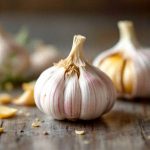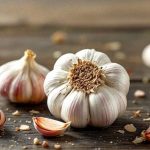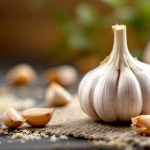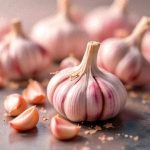Takeaways:
- Garlic and potassium work together to support heart health
- Both nutrients help regulate blood pressure
- Garlic boosts immunity while potassium maintains fluid balance
- The combination may improve muscle function and recovery
- Regular intake can contribute to stronger bones
- Proper dosage is essential to avoid potential side effects
The Dynamic Duo: Garlic and Potassium
Garlic and potassium are valuable nutrients that offer several health benefits when consumed together.[1] Garlic, a common herb with a strong flavor, and potassium, an essential mineral, work together to support various functions in the body.
These nutrients have complementary roles in the body. Garlic contains unique compounds that promote health, while potassium acts as an electrolyte, which helps balance fluids.[2] This combination can contribute to improved overall health.
This article will discuss the health advantages of both garlic and potassium. We will examine their individual qualities and how they work together to create beneficial effects. This information will help you learn how to safely incorporate them into your daily food intake.
Garlic: Nature’s Flavor Enhancer
A Brief History
Garlic has a long history of use dating back thousands of years. Ancient cultures valued it for its medicinal properties and as a food source.[3] For example, Egyptians fed it to those building pyramids to give them strength, while Greeks and Romans used it to boost courage in their soldiers.
Over time, garlic’s role expanded from medicine to a common ingredient in cooking. Its distinct flavor enhances many dishes globally. Modern scientific studies now support the traditional uses of garlic, and it remains a popular natural remedy.
Nutritional Profile
Garlic is a nutrient-dense food. It provides a lot of beneficial nutrients while being low in calories. A single clove of garlic includes several important vitamins and minerals such as:
| Nutrient | Amount per clove |
|---|---|
| Manganese | 2% of Daily Value |
| Vitamin B6 | 2% of DV |
| Vitamin C | 1% of DV |
| Selenium | 1% of DV |
Garlic also provides small amounts of other important nutrients, like calcium, potassium and iron.[4] However, its primary health-promoting properties come from sulfur compounds that it contains.
Allicin is the main active compound found in garlic.[5] It’s created when garlic is crushed or chopped. Allicin is responsible for the distinct odor and many of the health benefits associated with garlic.
Health Benefits
Garlic has several potential health benefits. Research suggests that garlic may be able to:
- Support heart health
- Boost immune function
- Help fight infections
- Reduce blood pressure
- Lower cholesterol levels
Garlic is well known for its ability to strengthen the immune system. It can help the body defend against colds and the flu.[6] Some studies indicate that it could even help prevent certain types of cancer.
The sulfur-based compounds in garlic support the function of immune cells. These compounds increase the activity of natural killer cells, which are an important part of the body’s defense system against infections.
Potassium: The Essential Electrolyte
Understanding Potassium
Potassium is a mineral and an electrolyte, which means it helps regulate fluid balance in the body.[7] This mineral is important for healthy nerve signals and muscle contractions.
The body can’t produce potassium, so it must be obtained through food or supplements.[8] It works with sodium to regulate blood pressure and is also crucial for muscles and nerves to function correctly.[9]
Sources of Potassium
Many foods contain potassium. Some of the best dietary sources are:
| Food | Potassium Content (mg per 100g) |
|---|---|
| Dried apricots | 1162 |
| White beans | 561 |
| Spinach | 558 |
| Sweet potato | 337 |
| Banana | 358 |
Consuming a variety of fruits and vegetables is a good way to ensure sufficient potassium intake.[10] Dairy products and fish are also excellent sources of potassium. Try to incorporate foods rich in potassium in every meal.
It’s easy to increase your potassium intake. For example, add a banana to your breakfast, snack on dried fruit, or include leafy greens in your lunch salad. Making these small changes can greatly increase your potassium levels.
Potassium Deficiency
Low potassium levels can lead to various health problems. Signs of a potassium deficiency may include:
- Weakness and fatigue
- Muscle cramps
- Irregular heartbeat
- Constipation
Several factors can cause low potassium levels. These include:
- Excessive sweating
- Chronic diarrhea
- Certain medications
- Eating disorders
- Alcoholism
Maintaining a healthy potassium balance is important. It influences many of the body’s functions.[11] Too little potassium can be as harmful as too much. It’s best to consult a doctor if you suspect a deficiency.
Synergistic Effects of Garlic and Potassium
Cardiovascular Health
Garlic and potassium both support heart health, but in different ways. Garlic helps reduce cholesterol and blood pressure, while potassium is involved in regulating heart rhythm and blood flow.[12]
Together, garlic and potassium are a good combination for heart health. Garlic compounds help relax blood vessels, which allows blood to flow more easily. Potassium balances fluid levels, further supporting healthy blood pressure. Consuming both regularly can lower the risk of heart disease.
Muscle Function
Potassium plays a significant role in muscle health. It helps muscles contract and relax properly.[13] Without adequate potassium, you may experience muscle cramps or weakness.
Garlic may aid muscle recovery after physical activity. Its anti-inflammatory properties can reduce muscle soreness.[14] When combined with potassium, it may enhance overall muscle performance.
Athletes frequently focus on getting enough potassium. Adding garlic to their diet could enhance performance. This pairing may help reduce fatigue and speed up recovery times after intense workouts.
Bone Health
Potassium is important for maintaining strong bones.[15] It helps neutralize acids that can cause the body to remove calcium from bones. A diet high in potassium may lower the chance of developing osteoporosis.
Garlic might also support bone health. Some studies suggest it can increase bone density, especially in women after menopause.[16]
The combination of garlic and potassium could be beneficial for maintaining bone strength as people age. More research is needed to fully understand how they work together.
Incorporating Garlic and Potassium into Your Diet
Cooking with Garlic
Adding garlic to your meals is easy and adds flavor. Here are some simple tips:
- Crush garlic before cooking to release more compounds
- Add it to soups, stews, and sauces for flavor
- Roast whole garlic cloves for a milder taste
- Mix raw garlic into dressings and dips
Cooking methods affect garlic’s health benefits. Raw garlic contains the most active compounds, but cooked garlic is still beneficial.[17] It’s best to include both raw and cooked garlic in your diet.
Try adding minced garlic to your morning eggs, sprinkle it on roasted vegetables, or mix it into homemade salad dressings. These simple changes can easily increase your garlic intake.
Potassium-Rich Meal Planning
Increasing your potassium intake requires some planning. Consider these strategies:
- Start your day with a potassium-rich breakfast
- Include a fruit or vegetable at every meal
- Choose whole grains over refined ones
- Snack on nuts and dried fruits
- Cook with potassium-rich ingredients
It’s important to plan meals that balance different types of nutrients. Combining potassium-rich foods with other healthy foods is important. For instance, combine spinach with lean protein and whole grains.
Remember to vary the types of potassium-rich foods you eat. Don’t rely on just one or two sources. Mixing up your choices will ensure you get a range of nutrients. This makes meal planning both interesting and more nutritious.
Potential Side Effects and Precautions
Garlic Considerations
While garlic is generally safe, some people may have side effects. These can include:
- Bad breath
- Digestive upset
- Increased bleeding risk
Garlic can interact with certain medications, such as increasing the effects of blood thinners.[18] If you take any medications, talk to your doctor before increasing your garlic intake.
Some people are allergic to garlic. Symptoms can include skin rashes and breathing problems.[19] If you notice any signs of an allergic reaction, stop eating garlic and seek medical advice.
Potassium Concerns
Too much potassium can be harmful. High potassium levels in the blood can lead to:
- Nausea
- Slow heartbeat
- Chest pain
People with kidney problems should be careful with potassium intake. Their bodies might not be able to remove extra potassium effectively, which can cause dangerous levels to build up in the blood.[20]
Certain medications can affect potassium levels in the body. These include some blood pressure drugs and diuretics. It is always a good idea to talk to your doctor about possible interactions.
Garlic and Potassium Supplements
When to Consider Supplements
Most people get enough potassium from the food they eat. Garlic supplements are more common. You might consider supplements if:
- Your diet lacks variety
- You have a diagnosed deficiency
- Your doctor recommends them
Supplements should not replace a balanced, healthy diet. They should only be taken to complement good eating habits.[21] It’s best to prioritize whole foods over supplements when possible.
Always consult a healthcare professional before starting any supplement. They can evaluate your individual needs and potential health risks. This is especially important if you have any existing health conditions or are taking medications.
Choosing Quality Supplements
When selecting supplements, look for these features:
- Third-party testing certification
- Clear labeling of active ingredients
- Proper dosage information
- Reputable brand names
For garlic supplements, aged garlic extract is well-studied. It may provide more consistent results than other forms.[22] Potassium supplements are available in different forms. Your doctor can suggest the most suitable one for you.
Keep in mind that supplements are not regulated as strictly as medicines. The quality of supplements can vary significantly between different brands. Do your research carefully when choosing a supplement, and remember that price is not always an indication of quality.
Myths and Misconceptions
Garlic Myths Debunked
Several myths exist about the health benefits of garlic. Let’s look at and correct a few of them:
Myth: Garlic cures colds instantly. Fact: While garlic may boost immunity, it’s not a cure-all. It can help prevent colds but won’t cure them overnight.[23]
Myth: Garlic lowers blood pressure immediately. Fact: Garlic’s effects on blood pressure are gradual. Regular consumption over time may help, but it’s not an instant fix.[24]
Myth: More garlic is always better. Fact: Moderation is key. Excessive garlic intake can cause side effects.[25]
Potassium Misunderstandings
There are also some misconceptions regarding potassium. Here are some common myths:
Myth: Bananas are the best source of potassium. Fact: While bananas are good, many foods have more potassium. Leafy greens and beans often contain higher amounts.[26]
Myth: Athletes need potassium supplements. Fact: Most athletes get enough potassium from food. Supplements are rarely necessary unless advised by a doctor.[27]
Myth: Low-sodium diets don’t need potassium. Fact: Potassium and sodium work together. Both are important for balance, even on low-sodium diets.[28]
Research and Future Directions
Current Studies
Recent research on garlic and potassium shows promise. Studies are looking at their effects on heart health and blood pressure. Here are some of the key areas of focus:
- Garlic’s potential to reduce arterial stiffness
- Potassium’s role in preventing strokes
- Combined effects on overall cardiovascular health
Researchers are also investigating garlic’s antibacterial properties. This could lead to new treatments for infections that are resistant to antibiotics.[29] Potassium studies are exploring its influence on bone health in older adults.
What’s on the Horizon
Future research may focus on:
- Garlic’s effects on gut health and the microbiome
- Potassium’s role in mental health and cognition
- New ways to enhance garlic’s bioavailability
- Personalized potassium recommendations based on genetics
Scientists are working to create new garlic extracts that maximize health benefits while minimizing side effects. Research on potassium is focusing on finding the ideal intake amounts for different groups of people.
The combination of garlic and potassium might open new possibilities. Researchers could study the combined effects of these nutrients on different health conditions. This may lead to new recommendations for diet or supplements.
FAQs
Can garlic lower blood pressure?
How much potassium do I need daily?
Is it possible to overdose on garlic?
What foods are highest in potassium?
Can I take garlic supplements with blood thinners?
Does cooking garlic reduce its health benefits?
How does potassium affect heart rhythm?
Are there any risks to eating too much garlic?
Conclusion
Garlic and potassium are powerful nutrients that have several benefits. They support heart function, muscle health and more. Together, they work synergistically to promote overall health and wellness.
Adding these nutrients to your diet is easy and beneficial. Garlic enhances flavor while providing health perks. Potassium-rich foods supply essential minerals needed by the body. Including both in your diet can help support various bodily functions.
Remember that balance is key. Too much of any nutrient can be harmful. Aim to eat a balanced diet that includes these nutrients naturally. If you’re thinking about taking supplements, consult with a healthcare provider first.
Stay up-to-date with the latest research. As scientific knowledge grows, we learn more about these nutrients. Use this knowledge to make informed choices about your health. Garlic and potassium can be valuable components of a healthy diet and support overall wellness.
Garlic contains compounds that have been associated with various health benefits, and potassium is an essential mineral for numerous bodily functions.
Source: “Revealing the Therapeutic Uses of Garlic (Allium sativum) and Its Potential for Drug Discovery” https://www.ncbi.nlm.nih.gov/pmc/articles/PMC8739926/
Garlic’s sulfur compounds are associated with health benefits. Potassium’s role in maintaining fluid balance is well-established.
Historical records from various cultures document the medicinal and culinary use of garlic.
While garlic does contain these nutrients, it is not typically consumed in large enough quantities to be a major contributor to daily intake.
Allicin is responsible for many of garlic’s characteristic effects, including its strong odor.
Garlic’s compounds have shown some potential to boost immune cells and functions, though not all studies demonstrate these results.
Source: “Garlic Lowers Blood Pressure in Hypertensive Individuals, Regulates Serum Cholesterol, and Stimulates Immunity: An Updated Meta-analysis and Review” https://pubmed.ncbi.nlm.nih.gov/26764326/
Potassium helps balance fluids inside cells and also works with sodium to regulate fluid balance in the body.
The human body does not produce potassium and depends on external sources for it.
Potassium plays a key role in the electrical activity of nerves and muscles, including the heart.
A balanced diet rich in fruits and vegetables can help meet daily potassium requirements.
Both too little and too much potassium can negatively affect health.
While these effects are typically seen with regular consumption as a part of a healthy diet, further studies are ongoing to solidify these claims.
Source: “Garlic Lowers Blood Pressure in Hypertensive Individuals, Regulates Serum Cholesterol, and Stimulates Immunity: An Updated Meta-analysis and Review” https://pubmed.ncbi.nlm.nih.gov/26764326/
Potassium’s role in muscle function is crucial and well-documented.
While the anti-inflammatory potential of garlic is promising, more direct research on athletic performance and recovery is required.
Potassium helps neutralize acids that can lead to bone loss, thereby helping to maintain bone health.
Source: “Dietary potassium intake, kidney function, and survival in a nationally representative cohort” https://www.ncbi.nlm.nih.gov/pmc/articles/PMC9535513/
Some studies show that garlic consumption may increase bone density in women after menopause. However, more comprehensive research is needed to confirm these findings.
Source: “Effects of garlic oil on postmenopausal osteoporosis using ovariectomized rats: comparison with the effects of lovastatin and 17beta-estradiol” https://pubmed.ncbi.nlm.nih.gov/16397916/
Heat can reduce the potency of some of garlic’s active compounds, but cooked garlic still retains some health benefits.
Garlic’s anticoagulant properties can increase the risk of bleeding if taken alongside blood-thinning medications.
Garlic allergies are rare but do exist and can cause various allergic reactions.
Kidney dysfunction can impair potassium regulation, leading to hyperkalemia (high potassium), which is potentially dangerous.
Prioritizing whole foods as a primary source of nutrients is recommended.
Aged garlic extract has been shown to have high bioavailability of its active compounds.
Source: “Garlic bioactive substances and their therapeutic applications for improving human health: a comprehensive review” https://www.ncbi.nlm.nih.gov/pmc/articles/PMC11194342/
The compounds in garlic may have an immune-boosting effect but are not an instant remedy for colds.
Garlic is not an instant fix but regular consumption may contribute to long term reduction of blood pressure.
Source: “The effect of aged garlic extract on blood pressure and other cardiovascular risk factors in uncontrolled hypertensives: the AGE at Heart trial” https://pubmed.ncbi.nlm.nih.gov/26869811/
While generally safe, large amounts of garlic may cause digestive issues, bad breath, and potentially increase bleeding risk.
Many other fruits, vegetables and legumes offer more potassium than bananas.
Supplementation is not normally needed by athletes unless there is a deficiency, as evaluated by a doctor.
Both minerals play a crucial role in regulating fluid balance, nerve function, and blood pressure. Proper balance is required.
Garlic compounds are being investigated as a potential source of treatments for antibiotic resistant infections.
Individuals need different amounts based on age, gender, and specific health conditions, including pregnancy.



